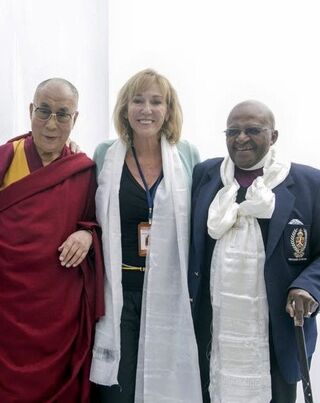Meditation
New Ways to Find Joy in a Troubled World
The Dalai Lama and Archbishop Desmond Tutu show how to find joy today.
Posted May 31, 2022 Reviewed by Abigail Fagan
Key points
- A new documentary offers the Dalai Lama’s and Archbishop Desmond Tutu’s strategies for cultivating joy, even in troubled times.
- Research shows that finding joy is good for our health, builds our personal resources, and can help us cope in difficult times.
- We can cultivate greater joy by connecting with others, meditating, savoring, and finding meaning.

It’s hard to find happiness in a world of personal and political turmoil, when so many people are suffering and our world seems to be falling apart. Yet Peggy Callahan’s new documentary, Mission: Joy, shows how the Dalai Lama and Archbishop Tutu found joy in their lives and offers powerful strategies to help us find greater joy in our own.
Research shows that moments of joy can help us cope during difficult times (Berrios, Totterdell, & Kellett, 2018). Experiencing joy is good for our health and can broaden and build our personal resources, helping us make wiser choices when we face problems (Fredrickson, 2001, 2003; Post, 2011).
To celebrate the Dalai Lama’s 80th birthday, Archbishop Tutu joined him in Dharamsala, India in 2015 for a week long series of dialogues on finding joy amid life’s inevitable suffering (Callahan, 2022; Dalai Lama, Tutu, & Abrams, 2016). Filmmaker Peggy Callahan recorded their meetings in what she says was “a gift of a lifetime.”
Here are four key strategies that emerged.
- Connection. In the film, we see Archbishop Tutu and the Dalai Lama constantly smiling, reaching out to clasp hands, laughing, and teasing one another. These two spiritual leaders, one Christian and one Buddhist, experienced a deep, heartfelt connection with one another. We all need connection. Research has shown that we can find this joy of connection with other human beings, with the dear people in our lives, but also in a sense of awe and connection with nature (Fredrickson, 2013; Van Cappellen, & Saroglou, 2012).
- Spiritual Practice. The Dalai Lama and Archbishop Tutu have been able to continually open their hearts to joy because of their deep commitment to meditation and prayer. The Dalai Lama meditates for four hours every morning, and the Archbishop would make his quiet time the first thing he scheduled each day. Peggy Callahan reflects that “being able to spend that internal time and quiet time actually helped them be more available and more open to others when they were with them.” And research shows that cultivating time for meditation helps us be more mindful, more empathically present to others in our lives (Shapiro & Izett, 2008).
- Authenticity. The Dalai Lama and Archbishop Tutu were authentic, Callahan says, “When they were unhappy, you knew it. When they were happy, you knew it.” Many of us try to hide our negative feelings, which blocks our energy. Their deep meditation practice gave these two men what psychologist Marc Brackett calls “permission to feel,” making them more accepting, more able to open their hearts to all of their feelings and able to feel greater compassion for those around them (Brackett, 2019; Shapiro & Izett, 2008).
- Finding Meaning. Both the Dalai Lama and Archbishop Tutu suffered tremendous hardships in their lives. The Archbishop experienced poverty, polio, and tuberculosis as a child, then years of suffering during the South African apartheid. The Dalai Lama was forced to flee for his life when the Chinese army occupied Tibet and since then has lived for over 50 years in exile. Yet, as Callahan says, “These men found meaning in the service to other people,” referring to Viktor Frankl, who realized that when we find meaning, suffering ceases to be suffering (Frankl, 1984). In the film, the Dalai Lama explains that, of course, he experienced exile with sadness but says that if he had stayed in his palace in Tibet, he would not have had the opportunity to reach so many people, to do more good.
To share short practices that can help us all find greater joy, Peggy Callahan contacted psychologist Elissa Epel, who recruited a group of researchers. They created a week long project in which participants can practice one micro act of joy for seven minutes a day—like making a gratitude list or connecting with others. At the end of the week each participant gets a printout showing which practices helped them the most and the scientists get data to increase their understanding. Anyone can join this Big Joy Project at the Greater Good Science Center.
Today, many of us live life at extremes, feeling that we have to choose between joy and sorrow: either being dragged down by suffering or hiding from denial and guilt. But Mission: Joy shows that there is another way: not either/or but both/and. The Dalai Lama and Archbishop Tutu demonstrate no tension between finding joy in their daily lives and working to relieve suffering. In the film, the Dalai Lama enjoys Tibetan rice pudding and Archbishop Tutu enjoys dancing at his friend’s birthday celebration. They are enjoying the present moment in what psychologists call “savoring” (Hurley & Kwon, 2013). In fact, research has shown that seeking joy in our lives actually makes us more effective when dealing with challenges (Berrios, Totterdell, & Kellett, 2018). As Callahan explains, Archbishop Tutu used to say, “when you’re trying to change the world, you have to have some fun, and you have to be fun to be with because you need other people to help you.”
This message of joy is vital for us today. “So many people are hurting in our world today,” Peggy Callahan says. “We've had a pandemic. But before the pandemic, we had a double tsunami of anxiety and depression that's only gotten worse. Our politics are tearing us apart. Our very existence is at stake with the environment. Life is really difficult for a lot of people.” In this series of dialogues, their last big mission together, Archbishop Tutu and the Dalai Lama wanted us to know “that we do have agency over joy in our lives.”
Their message of agency echoes what Viktor Frankl realized long ago: that the one freedom no one can take from us is the ability to choose our response to any situation in life (1984). Wherever we are, whatever life brings us, we can choose the path of greater joy and meaning.
***
This post is for informational purposes and should not substitute for psychotherapy with a qualified professional.
© Diane Dreher, PhD. 2022 All rights reserved.
References
Berrios, R., Totterdell, P., & Kellett, S. (2018). When feeling mixed can be meaningful: The relation between mixed emotions and eudaimonic well-being. Journal of Happiness Studies, 19, 841-861.
Brackett, M. (2019). Permission to feel. New York, NY: Celadon Books.
Callahan, Peggy. (May 25, 2022). Personal communication. All quotes from Peggy Callahan are from this source.
Dalai Lama, & Tutu, D. with Abrams, D. (2016). The book of joy. New York, NY: Penguin Random House.
Frankl, V. E. (1984). Man’s search for meaning. New York, NY: Washington Square Press. Originally published in 1946.
Fredrickson, B. (2001). The role of positive emotions in positive psychology. American Psychologist, 56, 218-226.
Fredrickson, B. (2003). The value of positive emotions. The American Scientist, 91, 330-335.
Fredrickson, B. (2013). Love 2.0: How our supreme emotion affects everything we feel, think, do, and become. New York, NY: Hudson Street Press.
Hurley, D. B., & Kwon, P. (2013). Savoring helps most when you have little: Interaction between savoring the moment and uplifts on positive affect and satisfaction with life. Journal of Happiness Studies, 14, 1261-1271.
Post, S. G. (2011). It’s good to be good: 2011 5th annual scientific report on health, happiness, and helping others. The International Journal of Person Centered Medicine, 1, 814-829.
Shapiro, S. L. & Izett, C. (2008). Meditation: A universal tool for cultivating empathy. In D. Hick, & T. Bien (Eds.), Mindfulness and the therapeutic relationship (pp. 161-175). New York, NY: Guilford Press.
Van Cappellen, P., & Saroglou, V. (2012). Awe activates religious and spiritual feelings and behavioral intentions. Psychology of Religion and Spirituality, 4, 223-236.


